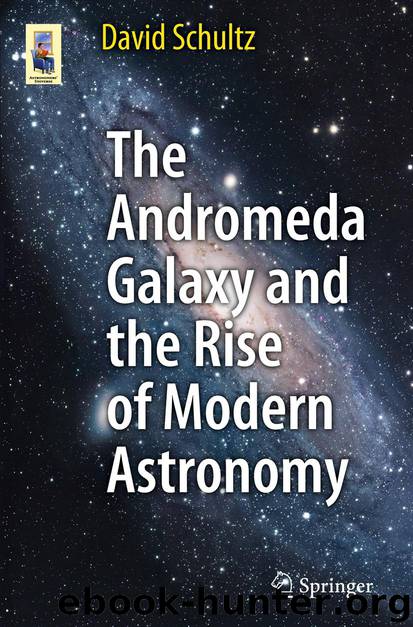The Andromeda Galaxy and the Rise of Modern Astronomy by David Schultz

Author:David Schultz
Language: eng
Format: epub
Publisher: Springer New York, New York, NY
When she re-plotted the relationship a definite linear relationship was revealed. She concluded that a star, for example, nine times brighter than another must be three times farther away. Her discovery, announced in 1912 in “Periods of 25 Variable Stars in the Small Magellanic Cloud,” helped establish the luminosity-distance formula for determining the proximity of two Cepheids from one another.
Simply stated, what Leavitt discovered is that the longer the period between the maximum and minimum, the greater its luminosity. Once one knows the average luminosity for a Cepheid one can then calculate its distance using a variation of the formula b = L/4 πd2 that was introduced earlier in this chapter. All that had to happen was to establish a true distance to Earth for one Cepheid, and that one could serve as a benchmark for others. The work of Harlow Shapely and others using parallax did just that, setting up Leavitt’s discovery as a means to calculating the distance to other Cepheids, and eventually to nebulae such as M31. Leavitt’s discovery would prove to be critical for Edwin Hubble in the 1920s, who noticed a Cepheid variable in the Andromeda Nebula and eventually used it to calculate distance and thereby resolve questions about size of the universe and whether M31 was part of the Milky Way or a separate galaxy.
Download
This site does not store any files on its server. We only index and link to content provided by other sites. Please contact the content providers to delete copyright contents if any and email us, we'll remove relevant links or contents immediately.
| Aeronautics & Astronautics | Astronomy |
| Astrophysics & Space Science | Comets, Meteors & Asteroids |
| Cosmology | Mars |
| Solar System | Star-Gazing |
| Telescopes | UFOs |
Tools of Titans by Timothy Ferriss(8212)
Turbulence by E. J. Noyes(7935)
Secrets of Antigravity Propulsion: Tesla, UFOs, and Classified Aerospace Technology by Ph.D. Paul A. Laviolette(5309)
Astrophysics for People in a Hurry by Neil DeGrasse Tyson(5130)
Room 212 by Kate Stewart(5035)
Design of Trajectory Optimization Approach for Space Maneuver Vehicle Skip Entry Problems by Runqi Chai & Al Savvaris & Antonios Tsourdos & Senchun Chai(5011)
Pale Blue Dot by Carl Sagan(4907)
The David Icke Guide to the Global Conspiracy (and how to end it) by David Icke(4624)
A Journey Through Divination and Astronomy by Publishing Pottermore(4340)
Goodbye Paradise(3724)
Apollo 8 by Jeffrey Kluger(3635)
COSMOS by Carl Sagan(3553)
Losing the Nobel Prize by Brian Keating(3498)
The Five People You Meet in Heaven by Mitch Albom(3474)
How to Read Water: Clues and Patterns from Puddles to the Sea (Natural Navigation) by Tristan Gooley(3406)
Brief Answers to the Big Questions by Stephen Hawking(3369)
How to Read Nature by Tristan Gooley(3249)
The Order of Time by Carlo Rovelli(3144)
A Brief History of Time by Stephen Hawking(2959)
